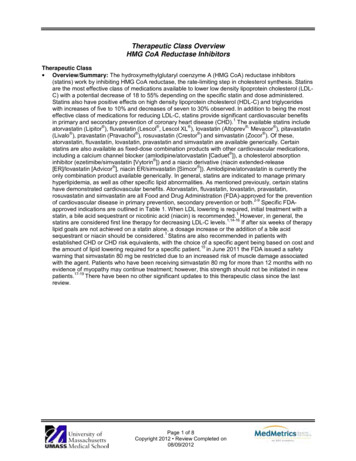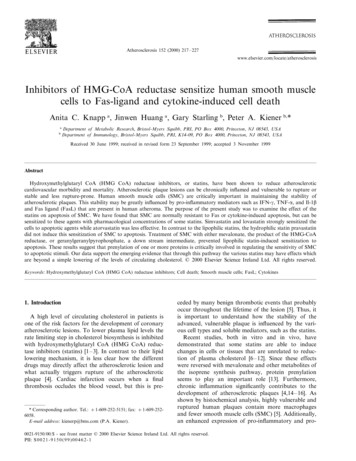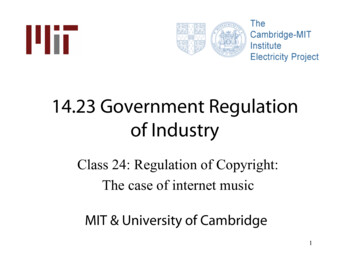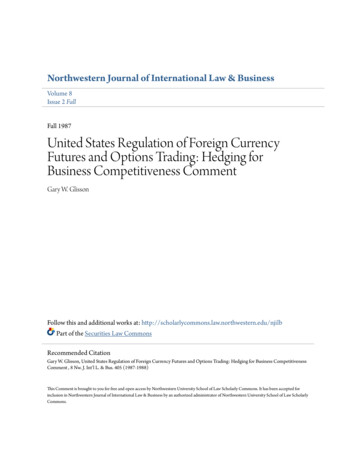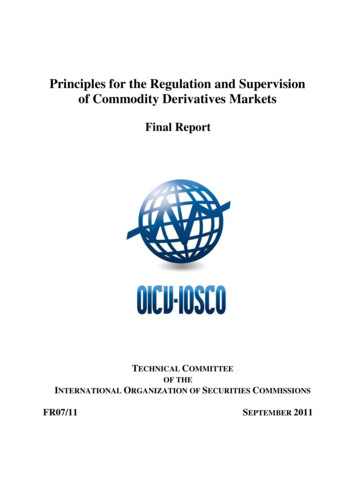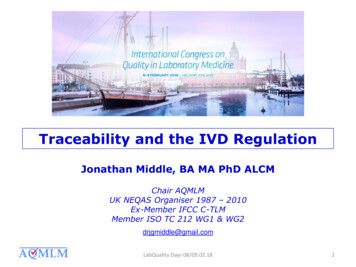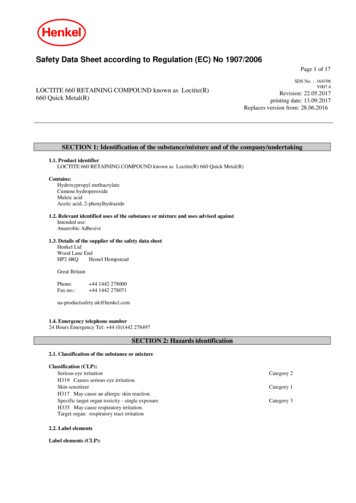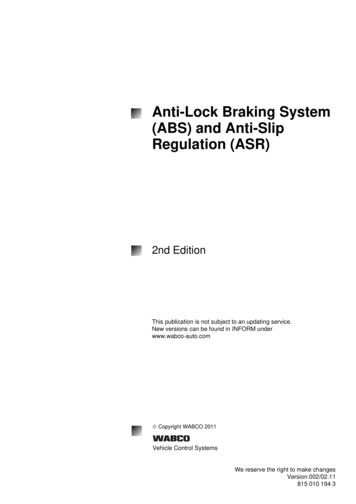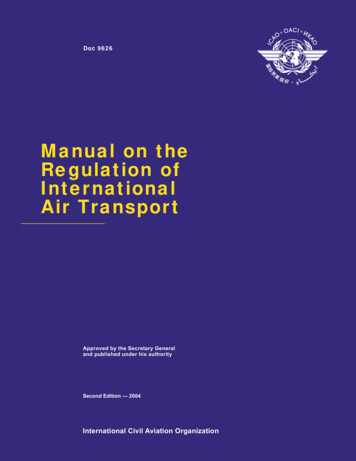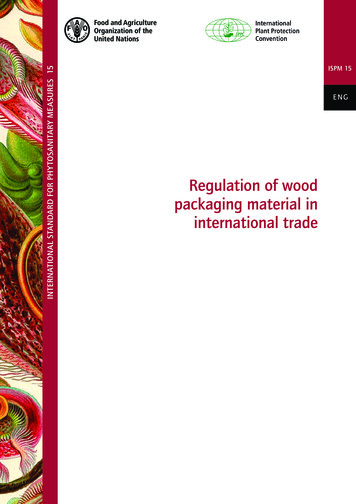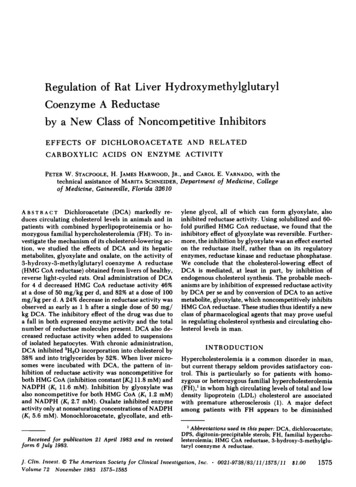
Transcription
Regulation of Rat Liver HydroxymethylglutarylCoenzyme A Reductaseby a New Class of Noncompetitive InhibitorsEFFECTS OF DICHLOROACETATE AND RELATEDCARBOXYLIC ACIDS ON ENZYME ACTIVITYPETER W. STACPOOLE, H. JAMES HARWOOD, JR., and CAROL E. VARNADO, with thetechnical assistance of MARITA SCHNEIDER, Department of Medicine, Collegeof Medicine, Gainesville, Florida 32610A B S T R A C T Dichloroacetate (DCA) markedly reduces circulating cholesterol levels in animals and inpatients with combined hyperlipoproteinemia or homozygous familial hypercholesterolemia (FH). To investigate the mechanism of its cholesterol-lowering action, we studied the effects of DCA and its hepaticmetabolites, glyoxylate and oxalate, on the activity of3-hydroxy-3-methylglutaryl coenzyme A reductase(HMG CoA reductase) obtained from livers of healthy,reverse light-cycled rats. Oral administration of DCAfor 4 d decreased HMG CoA reductase activity 46%at a dose of 50 mg/kg per d, and 82% at a dose of 100mg/kg per d. A 24% decrease in reductase activity wasobserved as early as 1 h after a single dose of 50 mg/kg DCA. The inhibitory effect of the drug was due toa fall in both expressed enzyme activity and the totalnumber of reductase molecules present. DCA also decreased reductase activity when added to suspensionsof isolated hepatocytes. With chronic administration,DCA inhibited 3H20 incorporation into cholesterol by38% and into triglycerides by 52%. When liver microsomes were incubated with DCA, the pattern of inhibition of reductase activity was noncompetitive forboth HMG CoA (inhibition constant [Ki] 11.8 mM) andNADPH (K; 11.6 mM). Inhibition by glyoxylate wasalso noncompetitive for both HMG CoA (K1 1.2 mM)and NADPH (K1 2.7 mM). Oxalate inhibited enzymeactivity only at nonsaturating concentrations of NADPH(K, 5.6 mM). Monochloroacetate, glycollate, and ethReceived for publication 21 April 1983 and in revisedform 6 July 1983.ylene glycol, all of which can form glyoxylate, alsoinhibited reductase activity. Using solubilized and 60fold purified HMG CoA reductase, we found that theinhibitory effect of glyoxylate was reversible. Furthermore, the inhibition by glyoxylate was an effect exertedon the reductase itself, rather than on its regulatoryenzymes, reductase kinase and reductase phosphatase.We conclude that the cholesterol-lowering effect ofDCA is mediated, at least in part, by inhibition ofendogenous cholesterol synthesis. The probable mechanisms are by inhibition of expressed reductase activityby DCA per se and by conversion of DCA to an activemetabolite, glyoxylate, which noncompetitively inhibitsHMG CoA reductase. These studies thus identify a newclass of pharmacological agents that may prove usefulin regulating cholesterol synthesis and circulating cholesterol levels in man.INTRODUCTIONHypercholesterolemia is a common disorder in man,but current therapy seldom provides satisfactory control. This is particularly so for patients with homozygous or heterozygous familial hypercholesterolemia(FH),' in whom high circulating levels of total and lowdensity lipoprotein (LDL) cholesterol are associatedwith premature atherosclerosis (1). A major defectamong patients with FH appears to be diminished1 Abbreviations used in this paper: DCA, dichloroacetate;DPS, digitonin-precipitable sterols; FH, familial hypercholesterolemia; HMG CoA reductase, 3-hydroxy-3-methylglutaryl coenzyme A reductase.J. Clin. Invest. The American Society for Clinical Investigation, Inc. * 0021-9738/83/11/1575/11 1.00Volume 72 November 1983 1575-15851575
binding and uptake of LDL by many cells (2). Theconsequent decrease in the utilization of LDL cholesterol results in loss of feedback inhibition of 3-hydroxy3-methylglutaryl coenzyme A reductase (HMG CoAreductase), the rate-limiting enzyme of cholesterolbiosynthesis (3). Overproduction of cholesterol andreduced catabolism of LDL are thus considered to bethe principal cause of hypercholesterolemia in thisdisease (1).Pharmacologic intervention for patients with FHhas traditionally relied on drugs, such as anionic resins,that enhance intestinal cholesterol excretion (4, 5), orthose, such as nicotinic acid, that impair synthesis oftriglyceride-rich precursors of LDL (6). Recently,however, competitive inhibitors of HMG CoA reductase, such as compactin (7) and mevinolin (8), havebeen developed and have been used in preliminarytrials for treatment of heterozygous FH (9-11). Although these drugs are potent inhibitors of reductasein vitro, the competitive nature of the inhibition leadsto a compensatory increase in enzyme synthesis (12),an effect that could lead to tachyphylaxis with chronicuse. In addition, these drugs may not be effective inpatients with homozygous FH (9), in whom high ratesof endogenous cholesterol synthesis are thought to occur. There is need, therefore, for an improved treatment of the hypercholesterolemia associated with thisdisorder.The pharmacologic and therapeutic effects of dichloroacetate (DCA) have been extensively exploredduring the past several years. DCA stimulates glucoseuptake. and utilization by peripheral tissues (13-15)and inhibits hepatic gluconeogenesis (16-18). It hasbeen used to reduce hyperlactatemia in patients withlactic acidosis (19). DCA also exerts noteworthy effectson lipid and lipoprotein metabolism. In rats, the druginhibits fatty acid and ketone body oxidation by peripheral tissues (13, 14) and is reported either to inhibit(20) or to stimulate (21, 22) fatty acid synthesis in liverwithout altering hepatocellular morphology (21, 23).In addition, DCA reduces circulating triglyceride andcholesterol concentrations in obese (24) and diabetic(23, 25) animals, but not in healthy animals (24, 25).In patients with phenotypes Ilb or IV hyperlipoproteinemia, with or without type II diabetes, DCA decreases plasma cholesterol and triglyceride levels (26).Furthermore, in two patients with homozygous FHwho lacked cell surface LDL receptor activity, thedrug induced rapid and marked falls in circulatinglevels of total and LDL cholesterol, without alteringhigh density lipoprotein cholesterol concentrations (27).These results prompted us to explore the mechanismof the cholesterol-lowering effects of DCA. Since thedrug reduces cholesterol levels in LDL receptor-neg-1576P. W.ative FH patients, we reasoned it might suppress endogenous cholesterol synthesis. We now report thatDCA significantly decreases cholesterol synthesis in ratliver by acting as a noncompetitive inhibitor of HMGCoA reductase. It also significantly reduces hepatictriglyceride formation. The inhibitory effect on reductase is probably mediated both by DCA per se andby hepatic conversion of the drug to an active metabolite, glyoxylate, which exerts a noncompetitive, butreversible, inhibition on the enzyme.METHODSMaterialsChemicals were from the following sources: DL-3-hydroxy-3-methyl-[3-'4C]glutaric acid (55.1 Ci/mol), [414C]cholesterol (54 Ci/mol), 3H20 (100 mCi/g), and Biofluorliquid scintillation fluid from New England Nuclear (Boston,MA); DL-[2-3H]mevalonic acid lactone (625 Ci/mol) fromAmersham Corp. (Arlington Heights, IL); DL-HMG CoA reductase, digitonin, glyoxylate, oxalate, pyruvate, lactate,alanine, and all other amino acids, monochloroacetate, trifluoroacetate, and glycollic acid from Sigma Chemical Co.(St. Louis, MO); ethylene glycol, 2-chloroproprionate, 3chloroproprionate from Eastman Kodak Co., (Rochester,NY); trichloroacetic acid and Scintilene liquid scintillationfluid from Fisher Scientific Co. (Orlando, FL); and sodiumdichloroacetate from Tokyo Kasei Kogyo Co., Ltd. (Tokyo,Japan). Dr. S. Curry (Gainesville, FL) kindly established thepurity and homogeneity of DCA by gas chromatography,nuclear magnetic resonance spectroscopy, infrared spectroscopy, and elemental analysis. Other chemicals were frompreviously listed sources (28-30).Animals and drug treatment.Male Sprague-Dawley rats (250-300 g) from the University of Florida breeding colony were fed Purina rat chowad lib. (Ralston Purina Co., St. Louis, MO) and were exposedto 12 h of light (3:00 p.m. to 3:00 a.m.) and 12 h of darkness(3:00 a.m. to 3:00 p.m.) for at least 14 d before use. For bothin vivo and in vitro experiments, rats were killed at 9:30a.m., at the diurnal peak of reductase activity. For in vivostudies, drugs were dissolved in distilled water and administered by orogastric gavage either 1 h before each morningkilling or each morning for 4 d to rats lightly anesthetizedwith ether. DCA concentrations of 50 and 100 mg/kg wereused to reflect therapeutic and supratherapeutic doses usedpreviously in humans (26, 27). Control rats received onlydistilled water.Liver cell isolation and incubationIsolated, morphologically intact, hepatic parenchymalcells were obtained in high yield by a modification (28) ofthe technique of Berry and Friend (31). Livers were perfusedin situ with an oxygenated, calcium-free, Krebs-Henseleitoriginal Ringer bicarbonate buffer (pH 7.4) containing 0.05%collagenase. After a 30-45 min perfusion, isolated cells wereseparated from debris, washed, and resuspended in freshenzyme-free medium, as previously described (16, 28). Atleast 90% of the final cell preparation consisted of intactStacpoole, H. H. Harwood, Jr., and C. E. Varnado
parenchymal cells that excluded trypan blue stain. Cellswere incubated in 25-ml polycarbonate Erlenmeyer flasksat a concentration of 5 X 108 cells in a volume of 6.0 ml.Flasks were gently shaken in a 95% 02/5% CO2 atmosphereat 37 C for 90 min. The incubation medium contained 118mM NaCl, 4.7 mM KCI, 2.5 mM CaCI2, 1.2 mM KH2PO4,1.2 mM MgSO4- 7H20, 25 mM NaHCO3, 1 mM glucose, and1.5% bovine serum albumin (pH 7.4).Preparation of microsomal reductaseFrom hepatocytes. We isolated microsomes by previouslydescribed modifications (28, 29) of the method of Shapiro etal. (32). After incubation, 6 ml of cell suspension was transferred to 10-ml plastic centrifuge tubes and centrifuged at50 g for 2 min. The supernatant was discarded and replacedwith 3.0 ml of a hypotonic medium (buffer A) containing1.5 mM Tris buffer, 50 mM NaCl, and 18 mM EDTA (pH7.2). The cells were resuspended, transferred to Dounce homogenizers, and disrupted with 20 strokes of a loose fittingpestle. 7 ml of buffer B, containing 300 mM sucrose, 10 mMbeta-mercaptoethanol, 10 mM EDTA, and 50 mM NaCl wasadded to each tube. The suspension was centrifuged for 10min at 10,000 g, again for 10 min at 15,000 g to removemitochondria and associated HMG CoA lyase activity, andfinally for 60 min at 100,000 g. The supernatant liquid fromthe final centrifugation was decanted and the remaining microsomal pellet was frozen in dry ice/acetone and stored at-70 C for up to 3 wk. Before assay of HMG CoA reductaseactivity, pellets were resuspended in 300 pu of buffer C containing 50 mM imidazole, 50 mM NaCl, 5 mM dithiothreitol,and 1 mM EDTA (pH 7.5).From whole livers. DCA-treated rats were anesthetizedwith pentobarbital, their livers were excised and equal portions from three to four animals were pooled. All subsequentoperations were performed at 4 C. For the acute or chronicfeeding studies, 4-5 g of liver was homogenized in 20 ml ofbuffer B with a motor-driven Potter-Elvehjem pestle. Thehomogenate was centrifuged, and the microsomes were isolated, frozen, and stored as described above. For the kineticstudies with microsomal reductase, pooled liver fractions werehomogenized in buffer D (40 mM Tris [pH 7.5], 1 mM EDTA,5 mM dithiothreitol), which also contained 70 mM KCI, with10 strokes of a loose fitting Dounce pestle followed by 10strokes of a tight fitting pestle. After centrifuging the homogenate for 10 min at 27,000 g, the precipitate was discardedand the supernatant was centrifuged for 90 min at 105,000g. The supernatant was removed and the precipitate wassuspended in 0.38 ml of buffer D containing 70 mM KCI/gwet wt liver by gentle homogenization with a motor-drivenPotter-Elvehjem pestle. The suspension was divided into 2.0ml portions and frozen in liquid N2.Preparation of solubilized reductaseMicrosomal reductase was solubilized and purified 60-foldby the heat fractionation procedure described by Rogers etal. (33). Microsomes from the livers of 15 rats, killed at themiddark period, were washed with 350 ml of buffer D, whichalso contained 50 mM KCI, and centrifuged at 105,000 g for90 min. The washed microsomes were frozen overnight inliquid N2. Microsomes were subsequently thawed and incubated in 18 ml of buffer D, containing 50% glycerol, for1 h at room temperature. The microsomal suspension wasdiluted to 350 ml with buffer D, containing 1 M KCI, andcentrifuged at 105,000 g for 90 min. The microsomal pelletwas discarded and the reductase contained in the supernatantwas precipitated between 35 and 50% ammonium sulfatesaturation. The precipitate was dissolved in buffer D, containing 1 M KC1 and 30% glycerol, heated in a 60 C waterbath for exactly 5 min, cooled to room temperature, andcentrifuged at 20,000 g for 30 min. The resulting supernatantwas retained as solubilized reductase, frozen in liquid N2,and used within 1 wk. Under these conditions, solubilizedreductase retains full activity.Assay of enzyme activityAssay of microsomal HMG CoA reductase. HMG CoAreductase activity was measured essentially as described byHunter and Rodwell (34). Samples to be assayed, in a totalvolume of 50 gl, were mixed with 25 u1 of a cofactor-substrate solution that contained 2.25 gmol glucose-6-phosphate, 0.26 gmol NADP , 0.2 U of glucose-6-phosphate dehydrogenase, 3.8 ,umol EDTA, 18,000 cpm of DL-[23H]mevalonolactone (629 Ci/mol) as an internal standardand either 25 nmol of RS-[3-14C]HMG CoA (2.5 cpm/pmol)or 60 nmol of RS-[3-14C]HMG CoA (12-15 cpm/pmol). Afterincubation of up to 30 min at 370C, the reaction was stoppedby addition of 10 pA of 6 M HCI. 30-pA portions were appliedto silica gel thin-layer chromatography (TLC) sheets ruledinto 16 chanels of 15 X 10 cm. Sheets were dried and developed in toluene/ace
3-hydroxy-3-methylglutaryl coenzyme A reductase (HMGCoAreductase) obtainedfromlivers ofhealthy, reverse light-cycled rats. Oral administration of DCA for 4 d decreased HMGCoA reductase activity 46% at a dose of 50mg/kgper d, and82%at a dose of 100 mg/kgperd. A24%decreasein reductaseactivity was observed as early as 1 h after a single dose of 50 mg/
